 |
[September 20th 2005]
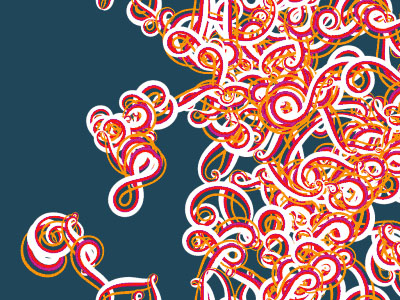
Marius Watz: System_C, 2004. http://systemc.unlekker.net/
Generative Art Now
An Interview with Marius Watz
Marius Watz is a Norwegian artist and curator who originally took his point of departure doing graphics for the raves of the early nineties. In his current artistic practice he focuses on computationally generated form, describing his own style as a particular brand of visual hedonism, marked by colourful organic shapes and a 'more is more' attitude. His work has been shown at many
international festivals and exhibitions.
Marius is currently organizing the conference and exhibition Generator.x in Oslo, Norway. This event deals with the current role of software and generative strategies in art and design.
Thomas Petersen asked Marius a few questions about his understanding of the term 'generative art', about his own artistic practice and of course about Generator.x.
Generator.x: The conference takes place at Atelier Nord in Oslo, September 23-24, 2005. The exhibition opens September 23 at the National Museum in Oslo and will tour until 2008. It has an exciting line-up of artists e.g. Casey Reas, Ben Fry, Martin Wattenberg, Golan Levin (to mention a few).
Generator.x will also feature club events. Learn more about the events at the great blog: www.generatorx.no, which is also an awesome resource on developments in generative art.
Generative art is often understood exclusively as software generated abstractions. I personally understand the term as a much broader range of strategies involving both digital and non-digital systems and processes bridging specific art traditions and media. How do you understand the elusive term 'generative art'?
Generative art describes a strategy for artistic practice, not a style or genre of work. The artist describes a rule-based system external to him/herself that either produces works of art or is itself a work of art. I agree with Philip Galanter that work with generative qualities can be found throughout art history, but I typically use the term to describe computer-based work created from the 1960s to today. I consider much of the work in abstract painting and sculpture done in the 1960s as essential for the understanding of generative art. Riley, Vasarely, LeWitt etc. are all important references.
For the term generative art to have any meaning when applied to a given work, the aspect of generativity must be dominant in the work. Many computer-based art projects have generative elements, but are not concerned with generative systems as an end result. As you point out, these days generative art is typically connected with software-based abstractions. I think the popularity of the term is due to an emerging group of younger artists and designers concerning themselves with code as an aesthetic material. This naturally leads to explorations of the ways code affects both the artistic process and the end result, including a materiality of algorithms etc.
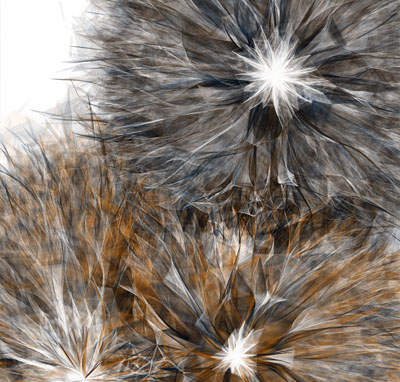
Casey Reas: Process 6 (Software 2), 2005. http://www.reas.com
I think it's interesting to note the differences between this recent group (exemplified by people like Casey Reas, Lia, Joshua Davis) and the preceding generation of generative artists, such as the Algorists, Jean-Pierre Hébert, Manfred Mohr, Roman Verostko or even Jean Tinguely. The approaches can often be similar, but I have the feeling that the 'why' of the work is different. Younger artists have so far been a little naive when it comes to considering generative work in an art historical context, but I think there is no doubt that the intention behind their work is frequently quite different from the painters who took up the keyboard in the 1960s and started to code.
It's also important to recognize that there are a number of reasons why artists may be attracted to generative work. Some want to explore scientific issues in an artistic context, some are looking to create solutions not possible in traditional animation or interaction design, others are interested purely in form and structure. I know several artists (including myself) who would say that code is the only way they can express their aesthetic ideas. The computer is the great democratizer, as it removes the need for manual skill. I also think the recent trend of generative visual performance systems is important, since it points to an effort to create visual instruments that have the same potential for expression as their musical counterparts.
If we understand generativity as a very general method or strategy, which in itself does not have a specific position in art discourse, how can the term be useful at all as a descriptive term? I mean, even though this trait is dominant in an artwork, the term often tells us very little about the work.
In theory you're correct. Generative art defines itself through a methodology, not a specific type of output. However, in reality the group of artists who currently define themselves as generative artists do function as a group, creating works that can be placed in similar schools of thought and understood as coming out of similar artistic interests.
In the last 10 years a number of people found themselves working with code as a hybrid practice, often coming from a self-taught background like myself or migrating from other fine art or commercial work. They were not often understood, and were isolated from traditional art discourse. In the last few years this group has gained the respect of the art world, at least to the extent that there is now a core group of successful artists creating new works and exhibiting with continuity. I suspect that it's similar to the emergence of other artist groups over the years, look at Pop Art, Fluxus, Kinetic art etc.
It's extremely rare that anyone (no matter how brilliant) has an idea that is not also being had by similar people with similar backgrounds and skill sets. Famously, the invention of the telephone was claimed by several inventors within a short time period (hours, even). Creating visual work through programming in 1993, I was convinced that this was a fundamentally new experience, and that others would realize it too. So I've pretty much waited 10 years for generative art to become an identifiable art phenomenon, always expecting it to happen.
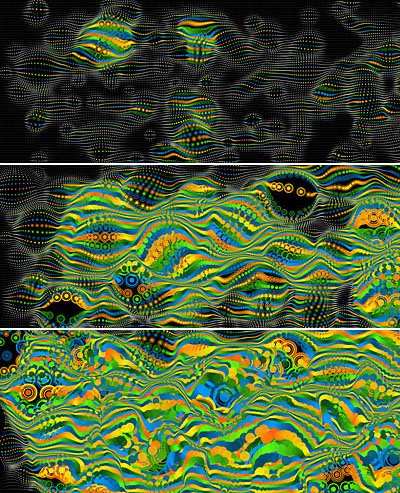
Marius Watz: Three stills from Electroplastique, 2005. http://www.unlekker.net/proj/electroplastique/
You have often used the term 'visual hedonism' in connection to your own work. In an art world, which at times can seem overtly concerned with conceptual and contextual strategies, what is the role of visual pleasure - and even beauty?
Form is its own content, capable of transporting the viewer through non-verbal means. A large part of this experience is the pleasure one feels upon seeing something that gives a sense of wonder. In this sense I am certainly interested in visual hedonism. Since 1960s the arts have become less concerned with aesthetics, and more with social and political phenomena.
My visual work was born out of experiences with the techno rave scene of the early 90s, so hedonism is an inevitable subject for me. At that time I discovered that I could turn my interest in code into visual expressions, something that had previously been impossible (I can't draw!). The resulting work was an attempt to express how I felt about the music I listened to at the time through coded processes.
I also worked as a graphic designer for many years, doing my own projects in parallel to client-based work. As a result I am acutely aware of visual culture in general, one of my slogans has been 'There is no culture like pop culture.' I'm aware that in much of the art world popular culture is viewed with scepticism at best, but I've always been informed more by street culture than by high art. I love the Darwinistic evolution of visual trends and fashions. Any given time period will express its identity through its visuals, from the übercoolness of the 80s, to the grunge of the early 90s and the hyper-modernism that accompanied our entering into the new millennium.
Having said that, the pop culture has its limitations in the form of a lack of willingness to examine ideas more deeply. I decided to abandon traditional commercial work completely in 2003, as I had ultimately lost the pleasure I once found in it. Since then my own work has become more focused as a pursuit of pure form as an end in itself.
My visual style tends towards extremes, taking colour strategies and form systems that clearly have an origin in the pop culture, but are exaggerated to the point where conventional aesthetic expectations break down. I work with code as a way to create visual systems, exploring the material qualities of different algorithmic approaches, seeking to surprise myself as much as anyone else.
You recently developed an installation (The Universal Digest Machine, which received an Honorary Mention at Ars Electronica), utilizing a more abstinent aesthetic. Tell me about the motivation for this development in your artistic practice.
The Universal Digest Machine is a funny beast, and represents a departure for me in two ways: One, it's an installation. Two, it's not concerned with aesthetics on a visual level. It deals with the impossibility of understanding the information space of the World Wide Web on a human level, much the same way humans can't image time on a geological scale.
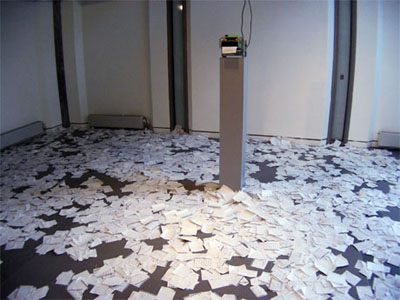
Marius Watz: Universal Digest Machine, 2005. http://spider.unlekker.net/
I was asked to create a new work for an exhibition in Stavanger, Norway, that dealt with the subject of language. It made me think of a series of experiments I did with computer-generated writing a long time ago, and wondered if I could use the Internet as a data source. I think it's the dream of any coder who loves the Internet to create a web spider, It's a very common God complex. So I suddenly had an excuse for writing a spider, which I decided would digest web pages and produce some form of analysis that was meaningless yet hinted at this huge data sphere in a seductive way.
Instead of stretching the project to fit a visual interpretation I decided to let the output be as useless as the process itself. In the installation the only element on display is an industrial thermal printer standing on a plinth. It's a type of printer intended for integrating into ATMs and other Point-of-Sale technology, and so it is extremely stable for long-term operation. It also looks quite rough, since it's not built into a casing like most printers people know.
Whenever a web page has been spidered (a process which the user never sees), the installation prints out a physical confirmation receipt with the title of the page, the URL and a list of the most commonly used words on the page. The printer will hold the note on display for about 10 seconds. If no one takes the receipt, the printer will drop it to the floor, where it will join thousands of pretty much identical pieces of paper. After a couple of weeks, the piece is literally trashing up the place.
The irony implied is that while you have all these receipts - all of which are genuine representations of the real-life internet, including hardcore porn, sports, spam and pro-Bush bloggers - they don't really tell you anything at all. Information is useless in such large amounts. The Digest Machine has turned out to be more effective at illustrating this point than I had ever hoped. There is something magical yet pathetic about this smart machine doing such an obviously unintelligent thing...
You are currently in the process of organizing the Generator.x conference and exhibition. Tell me a bit about which aspects of generative art you have focused on. Where is generative art going these days and which issues are important to focus on?
Generator.x is a framework for thinking about generative practices and creative uses of code, whether applied to art or design. We have identified some key subjects: Generative aesthetics, process-based design, performative software and tools by artists for artists. By inviting leading practitioners in the field I hope to introduce the field to newcomers, as well as provide a platform for new discourse.
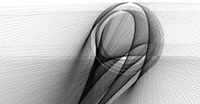 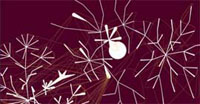
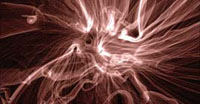 
Artists from the Generator.x exhibition. From left to right:
Lia: re-move.org, Ben Fry: Anemone,
Golan Levin: AVES, Martin Wattenberg: Shape of Song.
I took the initiative to start the project by planning the conference with Atelier Nord, who generously gave me 100% support from day one. Then I got the National Touring Exhibitions (now part of the new National Museum) to come on board to organize a touring exhibition, which we've been so lucky to be able to premier in the new exhibition space of the National Museum right in the middle of Oslo. I'm obviously happy about that since it means we automatically get a lot more cultural clout in terms of attracting a general public.
It is my experience, generative art suffers under being more concerned with formal issues than the rest of the electronic art field. In many ways it has more in common with older discussions in art history, and so does not quite fit in with festivals curated along socio-political lines. In fact there has been some friction (in my eyes unnecessarily) between the software art and generative art scenes, with the implied accusation being that generative work is nothing but pretty pictures. Generator.x aims to be a free space for looking at what it is about this kind of work that fascinates us, both from theoretical and aesthetic viewpoints.
The Generator.x exhibition is divided into two sections: 'Code as Material' and 'Code as Method'. This division reflects a basic difference in the use of generative strategies in art and design. In the 'Material' section we will show 4 new works by Casey Reas, Lia, Sebastian Oschatz and Trond Lossius. The first three are visual works, shown as projections, while Lossius is showing a generative sound art piece. The aim with this part of the exhibition is to show mature generative works by artists for whom code is their primary means of expression, and who have developed ways of using algorithms as aesthetic materials in such a way as to have a signature style and unique expressions.
In the 'Method' section we will show works on paper by Pablo Miranda Carranza, Lionel Theodore Dean, Ben Fry, Jürg Lehni, Golan Levin and Martin Wattenberg. These works range from classic data visualizations to design-oriented aesthetic applications. I'm quite pleased that we're able to show work by Lionel Theodore Dean, who is using rapid prototyping and procedural models to create unique design objects for commercial consumption. We will also present two artist-friendly coding tools, Processing and VVVV, as a way to explain the process behind the works and to give members of the audience a potential starting point in case they should want to explore code for themselves.
You mention a friction between software art and generative art scenes. What do you think the reason is for this friction?
Well, they are often confused by the art world, and I think that's a source of frustration for both groups. I think that has added to the need for software art and generative art to explicitly state their differences. But the philosophical frameworks are quite different, even though both deal with software as a material. Software artists are interested in software as a social and political construct, and often take an ironic or demagogic position. Many are involved in the Open Source movement as a part of their practice.
Generative artists focus on aesthetic systems, where the software is just an abstraction or tool used to create and display the work. Software art demands to see the code behind the systems ruling our world, while generative art is more often 'out of this world', unconcerned with social responsibility. Granted, the newer generation seems more hip to Open Source issues (and hence better at sharing their code), but they're still far from being politically engaged in software.

Martin Ignacio Bereciartua:
Letter-pairs analysis, 2005. http://www.m-i-b.com.ar/mib/letter_pairs/eng/
Besides the works you have selected for Generator.x, tell me about some generative works that inspire you, and which point out interesting future possibilities for generative art.
Alison Mealey's Unreal Art (http://alison.organised.info/unrealart/processing/) was a recent example. She seemingly effortlessly hacked up a way to monitor bots playing Unreal Tournament, and then put them to work basically as drawing robots. The Letter-pairs analysis (http://www.m-i-b.com.ar/mib/letter_pairs/eng/) by Martin Ignacio Bereciartua is also excellent, it has great motion.
I think these are exciting times for generative art, with some very talented artists doing excellent work. It's also much more mature and unique work than just 5 years ago, because the standards have been set and people know what to expect from the work. The scene is just established enough now that you have a field of 30-something 'veterans' and loads of emerging script kids. They really get what computational work is about. I think in digital design there is certainly no way back.
Generative visual performance tools will become more common, as a result of visual artists becoming involving in performance and wanting to go beyond the clip mixing VJ style. We're also seeing a lot of wonderful information visualization, yet more attempts at invoking the computational sublime. I think generative work will move off the screen to some extent, generative work initially gets a real boost from ease-of-distribution (a Flash SWF or applet is easy to show), but ultimately has to deal with the space of the screen.
I think generative art will make it into the commercial gallery scene, which will add its own benefits but also pitfalls. Are we really that keen on resuming a tradition based on limited copies, when we know that in reality our works have no such restriction? Nevertheless, even artists have to eat so some uncomfortable bedfellows may have to be found. I'm glad to see that the interest in computational work from commercial sources remains, having the occasional project with a decent budget and good infrastructure boosts the work.
More:
- Marius Watz: http://www.unlekker.net and www.evolutionzone.com
- Generator.x: http://www.generatorx.no
|
 |
|